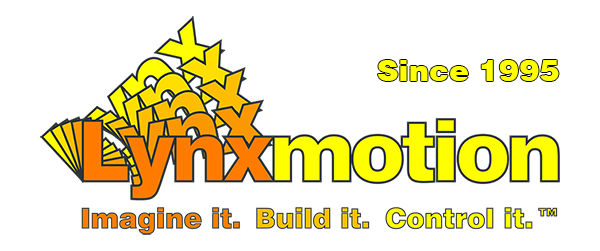Wiki source code of LSS FlowArm - Setup
Version 30.1 by Eric Nantel on 2022/06/20 15:20
Hide last authors
 |
26.1 | 1 | (% style="width:700px" %) |
 |
29.1 | 2 | |(% colspan="5" %)**Connecting via USB** |
| 3 | |(% style="width:10px" %) |(% colspan="4" %)1. Connect the USB cable to the Arm and PC & Power Adapter to the Arm XT60 | ||
| 4 | |(% style="width:10px" %) |(% colspan="2" %){{lightbox image="LSS-ADA-Power&USB-B.png"/}}|(% colspan="2" %){{lightbox image="LSS-ADA-Power&USB-A.png"/}} | ||
| 5 | | |(% colspan="4" %)2. Power the arm using the power supply ON/OFF switch. | ||
| 6 | | |(% colspan="4" %)3. Start the LSS FlowArm software (available [[HERE>>https://www.robotshop.com/en/lynxmotion-lss-lss-flowarm-app-download.html]]) | ||
| 7 | | |(% colspan="4" %){{lightbox image="https://wiki.lynxmotion.com/info/wiki/lynxmotion/download/ses-software/lss-flowarm/WebHome/LSS-FlowArm.png"/}} | ||
| 8 | | |(% colspan="4" %)((( | ||
 |
27.1 | 9 | 4. Select the type of LSS Arm you are using (3 DoF / 4 DoF / 5 DoF) |
| 10 | |||
| 11 | It will automatically try to find the connected Arm but, if not, you can manually choose the appropriate COM port from the drop-down list & the baud rate (default is 115200) | ||
| 12 | ))) | ||
 |
29.1 | 13 | | |{{lightbox image="LSS-ADA-Power&USB-B.png"/}} |
| 14 | | |(% colspan="2" %) | | | ||
| 15 | | |(% colspan="4" %)The software sends a query to servo ID1 and once a reply is received, it determines connection has been established and a green light will be displayed aside the COM port. | ||
| 16 | | |(% colspan="4" %) | ||
 |
9.1 | 17 | |
 |
3.2 | 18 | = Connecting via USB = |
| 19 | |||
| 20 | 1. Connect the USB cable to the LSS Adapter board on your robot | ||
| 21 | 1. Plug the USB connector into the PC | ||
| 22 | 1. Connect your LSS to the LSS-Adapter with the Lynxmotion cable | ||
| 23 | 1. Connect the power to the LSS Adapter via the yellow XT60 plug | ||
| 24 | 1. Power on the robot (On/Off switch) | ||
| 25 | 1. Start the LSS FlowArm software | ||
| 26 | 1. Select the type of LSS Arm you are using (3 DoF / 4 DoF / 5 DoF) | ||
| 27 | 1. It will automatically try to find the connected Arm but, if not, you can manually choose the appropriate COM port from the drop-down list & the baud rate (default is 115200) | ||
| 28 | 1. The software sends a query to servo ID1 and once a reply is received, it determines connection has been established and a green light will be displayed aside the COM port. | ||
| 29 | |||
 |
7.1 | 30 | = Calibration = |
 |
3.2 | 31 | |
| 32 | 1. Go in "TEACH" mode with the button on the top bar. | ||
 |
7.1 | 33 | 1. Manually place the arm in the correct position for your model and with the gripper closed. (see images bellow) |
 |
3.2 | 34 | 1. Store the values or Offsets by clicking "STORE OFFSETS" |
| 35 | 1. At that point the arm should "stay" in that position once released | ||
| 36 | 1. Exit the "TEACH" mode by clicking it again | ||
 |
7.1 | 37 | |
| 38 | = Calibration Positions = | ||
| 39 | |||
| 40 | |(% colspan="2" rowspan="1" style="text-align:center; vertical-align:middle" %)**4 DoF**|(% colspan="2" rowspan="1" style="text-align:center; vertical-align:middle" %)**3 DoF ** | ||
| 41 | |(% style="text-align:center; vertical-align:middle" %)[[image:[email protected]||width="200"]]|(% style="text-align:center; vertical-align:middle" %)[[image:[email protected]||width="200"]]|(% style="text-align:center; vertical-align:middle" %)[[image:[email protected]||width="200"]]|(% style="text-align:center; vertical-align:middle" %)[[image:[email protected]||alt="lss-flowarm-left-3dof.png" width="200"]] |

